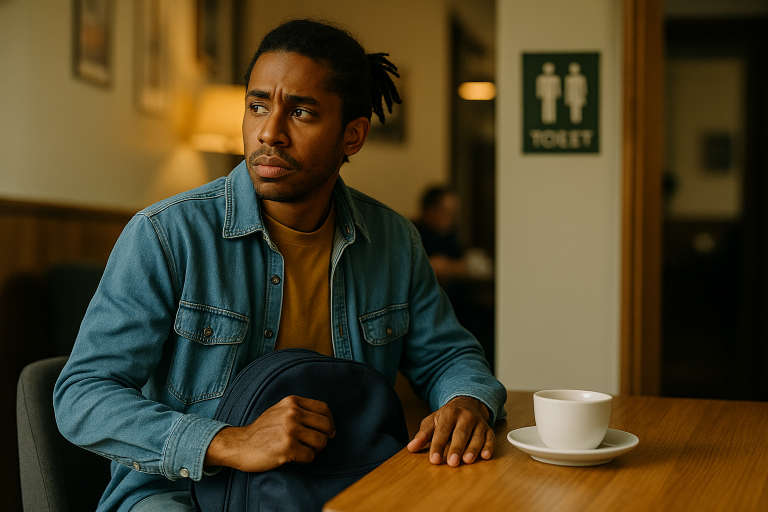On this page
What The Numbers Mean
This page summarises toilet anxiety statistics from our anonymised clinical dataset, with notes on what each figure does, and does not, mean.
We analysed 100 anonymised cases where toilet anxiety was the primary presenting problem. You’ll see headline rates, demographic notes, common patterns, and context such as sample size and wording, so the numbers don’t get misread.
If you want the plain English answer rather than the full list, read how common is toilet anxiety. If you want the clinician facing write up of method, limitations and early signals, see toilet anxiety interim research. If you want help rather than data, start with hypnotherapy for toilet anxiety.

Dataset Snapshot
These toilet anxiety statistics come from 100 anonymised cases where toilet anxiety was the primary presenting concern at intake. This is a clinical dataset from a help seeking group, so it is useful for spotting recurring patterns, but it cannot be treated as a population prevalence estimate.
The figures on this page are based on what clients reported, what was recorded at intake, and the consistent behavioural patterns that showed up across cases. Some variables are straightforward, age and gender for example, others depend on wording. A question like “have you ever had an accident” can be understood differently by different people, and that matters when you’re interpreting numbers.
We share this dataset for one main reason, to make the condition measurable. When a problem is measurable it becomes easier to discuss, easier to research, and harder to dismiss as “just in your head”.
Where These Numbers Come From
These figures come from 100 anonymised client cases where toilet anxiety was the primary concern at intake. This is not a population prevalence study, it reflects a help seeking group, so it can highlight patterns but it cannot be used to estimate how common toilet anxiety is in the general public.
What We Mean By Toilet Anxiety In This Dataset
To keep the page consistent, we use a practical working definition. Toilet anxiety here means persistent fear about not reaching a toilet in time, and the behaviours that follow, repeated toilet visits, route planning, avoidance, and safety habits. This is different from embarrassment about using public toilets, which can exist alongside it but does not describe the whole picture.
A few terms on this page need clarification.
- Accident, this is self reported and may include anything from a full loss of control to minor leakage, depending on the person’s definition. This means the number is still informative, but it should not be treated as a medical outcome measure.
- Duration, this is the length of time the client reported living with the problem, not the time since diagnosis.
- Able to delay, this refers to the person’s reported ability to postpone going in at least some situations. It does not mean the person felt comfortable, it means the feared urgency was not always matched by objective urgency.
What the Numbers Show
These toilet anxiety statistics summarise a clinical dataset of 100 cases. The aim is to show recurring patterns clearly, without over interpreting what the numbers can prove.
- 61 percent of people were women
- The average age was 39
- Most had been dealing with toilet anxiety for over 16 years before getting the right help
The ‘16 years’ figure matters because it suggests long delays before people seek the right kind of help. In practice that often means symptoms and coping behaviours become entrenched.
Under reporting is likely, many people do not disclose this problem openly.
How To Read These Toilet Anxiety Statistics
A single figure rarely tells the whole story. The value is in the pattern across figures. For example, a low rate of reported accidents can sit alongside a high rate of avoidance and planning behaviours, which suggests the fear is often driven by possibility rather than repeated real world occurrence.
Also, be cautious when comparing numbers across sources. Different studies, surveys, and clinics may use different wording, different inclusion criteria, and different definitions. That is why this page includes notes on what each number relates to, not just the number itself.
If you want a plain English overview of prevalence with only a few headline figures, read how common is toilet anxiety. If you want a clinician facing interim write up with methods, limitations, and early signals, see toilet anxiety interim research.
The Toilet Anxiety Statistic That Might Surprise You Most
Here’s something unexpected – 75 percent of clients have never had an accident as an adult.
In this dataset, a large proportion of clients reported never having an accident as an adult, even though their fear level was high and their lives were heavily organised around prevention. One way to read that is as a gap between the feared outcome and the person’s lived history, the mind is reacting to possibility rather than evidence, which is a common pattern in anxiety driven conditions.
This figure is based on self report, ‘accident’ can mean different things to different people, and a clinical dataset cannot be treated as a general population estimate.
Recognising the Patterns

When you look closely at the data, the consistency is hard to ignore. These were the most common behaviours among our clients:
- Using the toilet multiple times before leaving home
- Pre-planning routes to include toilet stops, or searching online before going anywhere new
Other commonly reported behaviours included limiting drinks before events, choosing seats near exits, and avoiding unfamiliar places. These are not diagnostic in isolation, but they help explain how the problem becomes self reinforcing over time.
Again, this is where toilet anxiety statistics are useful. They show you’re not overreacting. But they also show there’s a way out. Because the more predictable something is, the more workable it becomes.
